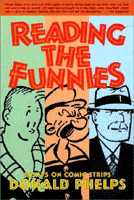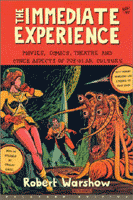
COMMENTARY
Funny, Books
[Click here to read feedback about this review.]
Curiously—because print has a certain residual respectability?—comic strips and even comic books get serious attention in publications that never so much as nod in the direction of animated films. I can't recall that the New York Review of Books has published anything related to animation since Robert Craft's dismissive consideration of Christopher Finch's Art of Walt Disney almost thirty years ago. Just in the last year or so, however, that intellectual flagship has published long, admiring pieces about Will Eisner, Pogo, and Spider-Man (the movie was the hook, but the review is as much or more about Marvel Comics). Art Spiegelman's prominent role as an illustrator for The New Yorker has led to meaty pieces by him for that magazine on Plastic Man and, miraculously, Bernard Krigstein.
Most of the people writing about the comics in such highbrow publications lack Spiegelman's in-the-trenches expertise, unfortunately. In 1998, when Jules Feiffer guest-edited an issue of Civilization, the Library of Congress' now-defunct slick bimonthly, that was devoted to the comics, he wrote that he had made a point of not inviting contributions from writers who were "infinitely more knowledgeable than anyone your guest editor has recruited for this enterprise." His idea, he wrote, was to "make this a presentation not of scholars' notes, but of fans' notes." The resulting articles by the likes of Studs Terkel (on the Katzenjammer Kids), Pete Hamill (on Milton Caniff and Roy Crane), and Alice Arlen (on Walt Kelly) were overwhelmingly shallow and ill-informed, just as could have been predicted.
The curious Feiffer rule—those who know very much about the subject matter are automatically disqualified from writing about it, regardless of their skills as writers—is in force at the New York Review, too. Instead of calling upon someone like John Benson to write about Will Eisner, NYR delegated the task to David Hajdu, biographer of Bob Dylan and Joan Baez. Hajdu's admiring essay, anchored in the DC hardcover reprints of Eisner's early Spirit stories and his recent graphic novels, betrays almost total ignorance of Eisner's postwar Spirit stories, by general consensus his best work. Brad Leithauser's review of Fantagraphics Books' wonderful Pogo reprint series dwells at inordinate length on Kelly's verse (Leithauser being himself a poet).
 Considering
how poorly the comics have been served by most critics, I was looking
forward to Donald Phelps's Reading
the Funnies (Fantagraphics Books, trade paper, $19.95),
a collection of essays on comic strips. The late Martin Williams
told me about Phelps many years ago, describing him as someone who
did the sort of work—studying years of comic strips on microfilm—from
which the writers in Feiffer's coterie would shrink in horror.
Considering
how poorly the comics have been served by most critics, I was looking
forward to Donald Phelps's Reading
the Funnies (Fantagraphics Books, trade paper, $19.95),
a collection of essays on comic strips. The late Martin Williams
told me about Phelps many years ago, describing him as someone who
did the sort of work—studying years of comic strips on microfilm—from
which the writers in Feiffer's coterie would shrink in horror.
Phelps has, indeed, done the work, but he is, alas, an undisciplined writer whose perceptions are buried in dense verbal undergrowth. If one word will not quite serve, he piles on others, in a pleonastic orgy—hoping, I suppose, that the right word will eventually turn up, or perhaps that the sheer bulk of a dozen not-quite-right words will fill the void left by the absence of the right one.
What is true of words is, in some of his pieces, just as true of ideas. His essay on Harrison Cady, the cartoonist who illustrated Thornton W. Burgess' books and drew the Peter Rabbit comic strip, is maddening because Phelps struggles titanically to get a grip on a cartoonist whose work is, whether you like it or not, just not that complicated.
 So,
sadly, Phelps's book is no antidote to the intellectual snobbery
that deforms most serious writing about the comics in mainstream
publications. Such snobbery has a very long history, as I was reminded
by reading a couple of pieces in the new edition of Robert Warshow's
The
Immediate Experience (Harvard University Press, trade paper,
$18.95).
So,
sadly, Phelps's book is no antidote to the intellectual snobbery
that deforms most serious writing about the comics in mainstream
publications. Such snobbery has a very long history, as I was reminded
by reading a couple of pieces in the new edition of Robert Warshow's
The
Immediate Experience (Harvard University Press, trade paper,
$18.95).
Although that book is subtitled "Movies, Comics, Theatre, and Other Aspects of Popular Culture," it includes only a handful of comics-related pieces. The most notable is "Paul, the Horror Comics, and Dr. Wertham," a rumination on eleven-year-old Paul Warshow's enthusiasm for the EC comics. The cover of the new edition reproduces a drawing by Al Feldstein for the cover of the first Weird Science-Fantasy annual, one of EC's science-fiction titles.
Warshow, who died in 1955 at the age of 37, wrote on political and cultural subjects with ferocious intellectual integrity, as exemplified by his essay on Julius and Ethel Rosenberg's prison letters. He was not a man who could tolerate dressing the mind in second-hand thought, especially the shabby, threadbare thought that Communists like the Rosenbergs wore gladly. But integrity can easily slide into rigidity, as happened when Warshow wrote on the comics.
Lionel Trilling speaks in his introduction of being told that Warshow "formed each sentence slowly in his mind, and, when it was satisfactory, wrote it down as irrevocable." No one who took his own writing seriously in just that way—hammering each sentence firmly into place, as if it were a brick in a wall, before passing on to the next—could have been sympathetic to the comics, where the constraints were so plentiful and so obvious, and in some respects so brutal.
From the perspective of a writer as serious as Warshow, observing those constraints would have been as painful as writing to fit on just a few subjects while limiting himself to a very simple vocabulary. (Like every writer, Warshow had favorite words, and two of his standbys, especially conspicuous where the comics were concerned, were "mechanical" and "vulgar.") That he wrote within constraints of other kinds—certainly, he had to approach writing for Commentary with a particular cast of mind—may not have occurred to him, or more likely, he did not feel those constraints as constraints at all.
I'm sure it never occurred to Warshow that certain kinds of artists could have felt the same way when they were working in the comics; or that they might have tolerated the constraints that the comics imposed on them because they found so much freedom to do satisfying work even within those constraints, especially when they were stimulated by the form itself. His failure to comprehend the all but boundless freedom that George Herriman found in Krazy Kat, despite the demands of daily deadlines, disqualifies his piece on that comic strip as serious criticism.
Warshow writes of reading Harvey Kurtzman's Mad with "irritated pleasure," but ultimately he cannot regard Mad as anything other than just a barely differentiated subspecies of the EC comic book, "a wild, undisciplined machine-gun attack on American popular culture." Kurtzman was anything but "undisciplined," but he observed a discipline that Warshow could not recognize as such. Like so many other writers on the comics, Warshow could not make the distinctions that are the critic's fundamental duty.
One day, Warshow took Paul and some of his friends to the EC offices in Manhattan, where they encountered the publisher, Bill Gaines, and one of the artists, Johnny Craig. Warshow seems not to have felt any qualms about associating with other people he wrote about (at least if they worked in more prestigious media), but there's no indication that he was curious enough about EC to ask Gaines what on earth he thought he was up to.
And if Warshow had encountered Kurtzman, to my mind one of the three great artists (the others being Carl Barks and Will Eisner) to work in comic books? What might have emerged from a conversation between those two men? Not a lot, probably. Kurtzman was never terribly articulate about his work. He spoke clearly only through what he put on his comics pages, and it's sadly apparent that, where the comics were concerned, Robert Warshow was, if not stone deaf, very hard of hearing.
[Posted May 2003]